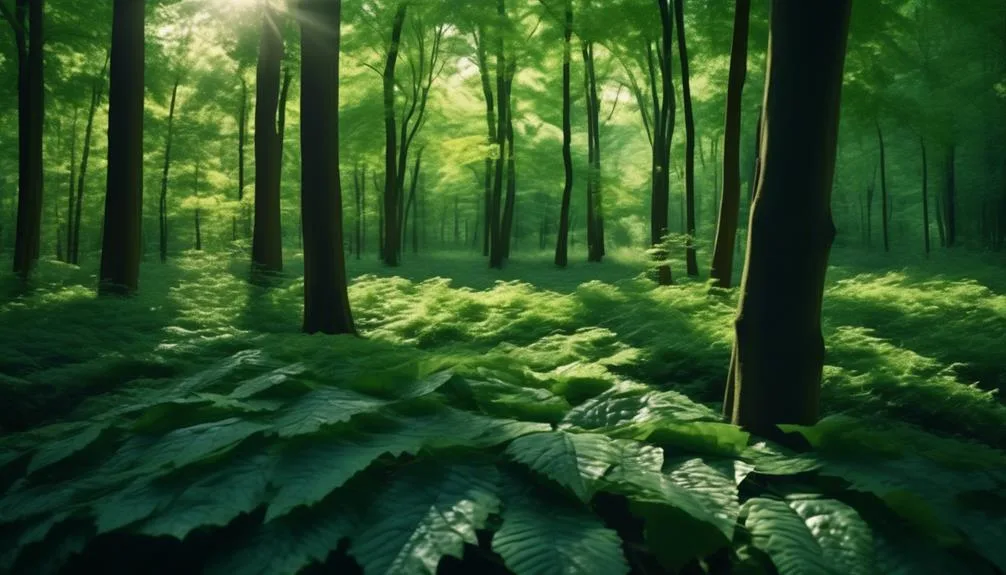Hickory trees have thick leaves, and there's a reason behind it.
The thick leaves are an interesting adaptation that helps these trees survive.
Exploring the intricacies of hickory trees reveals the reasons for their unique leaf structure and how it helps them thrive in tough environments.
Hickory Tree Characteristics
The hickory tree's distinctive bark and towering height make it a striking presence in any forest landscape.
Its compound leaves are made up of multiple leaflets attached to a central stem, giving them a feathery appearance. This leaf structure allows them to capture sunlight efficiently, aiding in the tree's robust growth.
Additionally, hickory trees are renowned for their abundant nut production. They produce hard-shelled nuts that are enclosed in a thick, green husk. These nuts are a valuable food source for wildlife and have been a traditional food source for humans as well.
The hickory's ability to produce such nutritious nuts has made it a vital component of many forest ecosystems.
Adaptation to Harsh Environments
Adapting to harsh environments, hickory trees have developed a remarkable resilience to thrive in challenging conditions, allowing them to endure and flourish amidst adversity.
Their leaf structure plays a pivotal role in this adaptation. The thick, leathery texture of hickory leaves helps reduce water loss through transpiration, a crucial adaptation for surviving in arid or windy environments.
Additionally, the waxy coating on the leaves serves as a protective barrier against environmental factors such as extreme temperatures, UV radiation, and even insect damage. This adaptation enables hickory trees to withstand harsh conditions and thrive in diverse habitats, ranging from dry uplands to moist lowlands.
Defense Against Herbivores
To deter herbivores, hickory trees deploy a range of chemical compounds and physical deterrents, making them a formidable challenge for would-be grazers. The chemical compounds present in hickory leaves, such as tannins and alkaloids, impart a bitter taste and can be toxic to herbivores, deterring them from feeding on the leaves.
Additionally, the leaf texture of hickory trees serves as a physical deterrent, with their thick, leathery leaves being difficult for herbivores to consume. These physical barriers make it harder for herbivores to access the nutritious tissues of the leaves, further reducing the likelihood of extensive herbivory.
Together, the chemical compounds and leaf texture of hickory trees form a robust defense mechanism against herbivores, ensuring the preservation of their foliage.
Efficient Photosynthesis
In the dense canopy of hickory trees, sunlight filters through the thick leaves, providing an ideal environment for efficient photosynthesis to occur.
The thick leaves of hickory trees play a crucial role in maximizing sunlight capture for photosynthesis. Their large surface area allows for more chlorophyll to absorb sunlight, increasing the tree's ability to convert light energy into chemical energy.
Additionally, the thickness of the leaves helps to reduce water loss through transpiration, contributing to water conservation. This adaptation is especially important in hickory trees, as they often thrive in areas with limited water availability.
Drought Resistance
The hickory tree's remarkable ability to withstand prolonged periods of little to no rainfall is a testament to its impressive drought resistance. This survival skill is attributed to the tree's efficient water conservation techniques and unique leaf structure. Here's why hickory trees excel in drought resistance:
- Water Conservation
- Hickory trees have developed deep root systems that can tap into groundwater, allowing them to access water during dry spells.
- Their leaves are coated with a waxy cuticle, which minimizes water loss through transpiration, helping the tree retain moisture even in arid conditions.
- Leaf Structure
- The thick, leathery leaves of hickory trees reduce water evaporation and provide insulation against harsh sunlight, enabling them to thrive in dry climates.
- The small pores on the leaves, known as stomata, open at night to minimize water loss, a key adaptation for conserving water.
Conclusion
In nature, the thick leaves of hickory trees serve as a multi-faceted survival tool, enabling them to thrive in challenging environments. Their unique features, from defense mechanisms to efficient photosynthesis, underscore the remarkable resilience of these trees.
Observing a hickory tree, one can't help but marvel at the intricate balance of adaptation and survival that their thick leaves represent.

My interest in trees started when I first saw the giant sequoias in Yosemite.
I was a teenager then, and I remember thinking, “I need to learn more about this.”
That moment stuck with me.
A few years later, I went on to study forestry at Michigan Tech.
Since graduating, I’ve worked in a mix of hands-on tree care and community education.
I’ve spent over ten years helping people understand how to plant, maintain, and protect the trees in their neighborhoods.
I don’t see trees as just part of the landscape.
They are living things that make a real difference in our daily lives.
